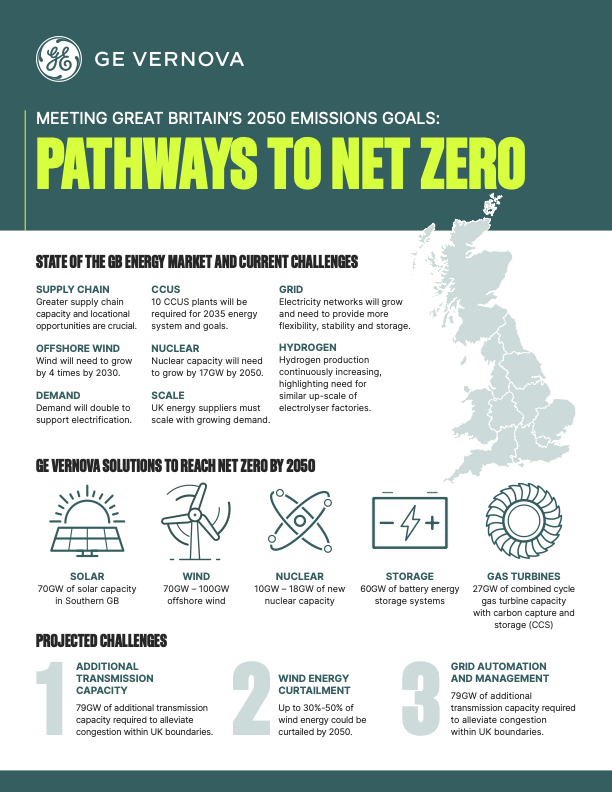- Additional 250 GW of renewable and decarbonised generation, approximately 2.5 times that of existing capacity, will need to be added to the power system.
- More than £50bn investment, twice as much as that of the past five years, is required in power generation and storage capacity alone this decade.
- 80 GW additional transmission line capacity is required along the Scottish and English boundaries, to optimise use of renewable electricity.
The analysis shows that:
- an additional 250GW of renewable and decarbonised generation will need to be added to the system.
- nuclear and gas power continuing to play an important role due to their reliability and grid congestion management characteristics.
- significant upgrade of grid infrastructure and operations will be required in addition to what is currently envisioned.
With the expectation that electricity demand will double (300-600 terawatt-hour) by 2050, including electrification of heating, transportation and industry to meet the decarbonisation goals, the study shows that an additional 250 GW of renewable and decarbonised generation, approximately 2.5 times that of existing capacity, will need to be added to the power system by 2050 across Great Britain. About two-thirds of the new capacity is expected to be wind and solar, with nuclear, abated gas and battery storage all playing an important role to accommodate for the intermittency of renewables and grid congestion.
Martin O’Neil, Vice President of Strategy at GE Vernova’s Gas Power business, said: “To meet the 2035 target and ensure secure, zero-carbon and affordable energy, Great Britain urgently needs an electricity market design which allows early-stage investment into renewable, lower carbon technologies, and the expansion of the electrical grid system. It is incumbent on policymakers to incentivise private capital providers with clear investment signals through net zero legislation and regulation as there is no silver bullet that will fast forward Great Britain’s electricity system to 2035 and deliver the net zero target. Forming private-public funding partnerships will be the cornerstone of adding additional capacity and expanding the grid at speed.”
The study recommends enabling and accelerating investments in a combination of electricity generation, transmission, and system control or management technologies with supportive policy and regulatory measures, such as rapid permitting. It estimates that more than £50bn investment, twice as much as invested the past five years, is required in generation and storage capacity alone by 2030. Furthermore, the study suggests accelerating build out of committed capacity for this decade and additional capacity of new generation earmarked for the next decade to be delivered by 2030. Significant upgrade and expansion of the transmission capability will be inevitable to securely deliver energy from various generation sources to consumers from across Great Britain. In total, around 80GW of additional transmission line capacity across the Scottish and English boundaries will be required to alleviate congestion, avoid curtailment of renewable electricity, and save circa £80bn in cost to generate electricity by 2050. This needs to happen along with expediting market reforms that are technology agnostic. Progress on the key recommendations need to happen within the next three years to mitigate the risk of Great Britain falling short of achieving a decarbonised power system by 2035 and the 2050 net zero target.
Research methodology:
Credible least cost pathways of future generation and transmission investment in Great Britain were developed utilising assumptions of the UK electricity system from prominent public sources and an industry accepted modelling platform. The scenarios serve to illustrate how power plants under each pathway would operate to meet demand in the future and the implication on the system as a whole, in particular in relation to the transmission network. The model captures all existing and future power plant on the Great Britain system along with a simplified representation of the interconnection with neighbouring countries.
About GE Vernova:
GE Vernova is a dynamic accelerator comprised of our Power, Renewable Energy, Digital and Energy Financial Services businesses, focused on supporting customers’ transformations during the global energy transition.
For media enquiries, please contact:
Elissaveta Ivanova
GE Vernova Europe
[email protected]
+41 79 611 3848
end
